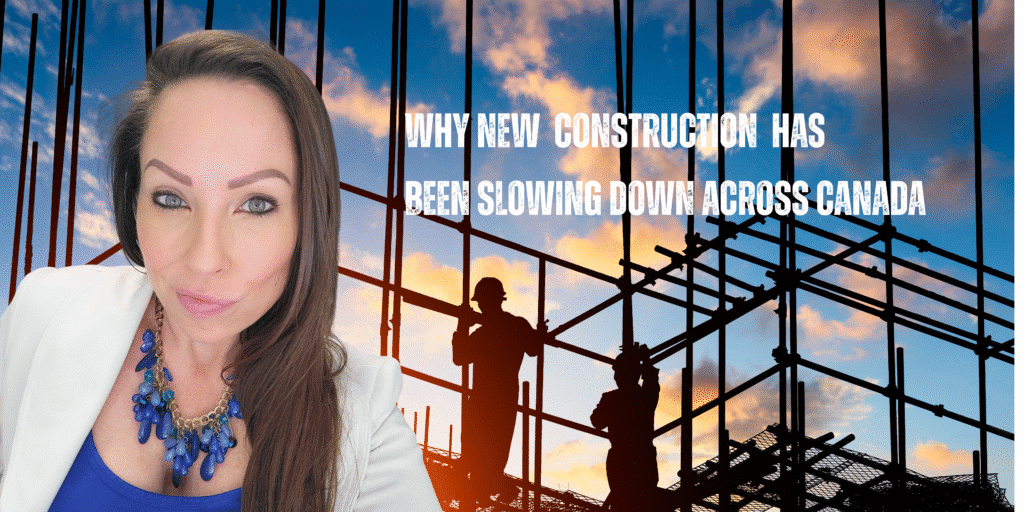
New Construction Has Been Slowing Down. But, Why?
Why New Construction Has Hit the Brakes in the GTA & Across Canada
There’s something unsettling about seeing cranes paused, construction sites dormant, and fewer green lights on permits — especially in areas like the GTA where growth has long been assumed. Over the past 18–24 months, new construction activity (particularly in condos and multi-unit housing) hasn’t just cooled: it’s dropped profoundly. But why? And what does this mean for housing supply, developers, buyers … and investors like you?
Here are the key drivers, plus some less obvious ones, and what to watch:
1. Interest Rates: The Price of Money Has Risen Sharply
This is the headline cause. The Bank of Canada’s rate hikes in 2022–2023 pushed fixed and construction borrowing costs way up. Higher interest rates impact:
- Financing cost for developers — land loans, construction loans, pre-construction cash flows all become more expensive.
- Pre-sale buyer demand drops. When borrowers / end-buyers see mortgage rates spiking, many step back. Condos especially suffer when pre-sales slow, since much of their financing & planning relies on presales.
- Carrying costs for projects already underway increase, delaying or halting projects with tight margins.
The data bears it out: CMHC estimated ~30,000 fewer housing starts in Canada in a recent period because higher interest rates depressed starts by 10–15%. BNN Bloomberg+2constructconnect.com+2
2. Surging Development, Land and Regulatory Costs
Even before interest rates, it was expensive to build in many GTA municipalities. But now:
- Development charges (DCs), permit fees, municipal levies have increased, sometimes dramatically. One report noted Toronto raised DCs on condos by ~42% in less than a year. https://preconstruction.info
- Construction materials, labour costs, supply chain inflation have pushed projects over budget. Even with pre-pandemic forecasts, many developers are being caught off guard.
- Land scarcity & land cost premiums: available (zoned) land for large scale builds, especially in desirable neighbourhoods with good transit or amenities, is limited — pushing up the cost of acquisition dramatically.
Thus, many projects that looked viable a couple years ago now have poorer margins or risk being unprofitable.
3. Demand Side Uncertainty & Weaker Pre-Sales
It’s not just costs that are hurting; demand has softened in key segments.
- New home / condo presales have plunged in the GTA. When people see interest rates high, future pricing uncertain, or are worried about downturns, they often delay or cancel purchases. This makes securing financing harder for developers. Clay Financial+2cadcr.com+2
- Existing home inventory rising: resale homes sometimes offer a more certain, faster purchase than waiting on a pre-construction condo. That diverts demand away. RBC+1
- The cost of servicing mortgages, even for buyers, is higher. That reduces the pool of buyers who can qualify or feel comfortable committing.
4. Regulatory and Approval Delays / Complexity
This often flies under the radar, but it matters.
- Permitting and approval times have stretched out. Between municipal reviews, zoning, site plan approval, environmental assessments (where applicable), and extra requirements (e.g. intensification, design guidelines) — the process drags.
- Misalignment among municipalities, between provincial & local policies, and NIMBY/ community push-back (on height, density, infrastructure, traffic, etc.) slows down what could otherwise move faster. https://preconstruction.info+1
- Cost of regulation: many new rules (energy efficiency, green building, etc.) increase up-front build cost, reduce speed, and require more robust capital or stronger proformas.
5. Labour, Supply Chain, & Construction Capacity Constraints
Building today is more complex in many ways than years past:
- Labour shortages in skilled trades increase wage inflation and delay project timelines.
- Materials costs are volatile (steel, lumber, insulation, finishes) and sometimes hard to predict or secure.
- Some suppliers or subcontractors may be over capacity or slow, especially when market conditions turn uncertain, meaning developers build in buffers or delay projects.
6. Inflation & Risk Premiums
Even non‐interest cost inflation eats into viability. Risk has increased everywhere: for developers, lenders, investors.
- Inflation on materials, land carrying costs, utilities, and also unpredictable costs (like energy, regulation compliance) require developers to build in risk margins, which reduce affordability or push up asking prices.
- Uncertainty around future policy (taxes, environmental rules, densification rules, government incentives) adds risk or hesitation.
7. Macro & Policy Headwinds
Some bigger picture forces:
- Affordability crisis: buyers and renters are stretched, so even when new homes are built, fewer can afford them. This feeds back to demand drying up for high‐end/new homes.
- Mortgage stress tests, tighter lending standards, and higher qualifying costs means many potential buyers are frozen out.
- Government policy: sometimes well-intentioned programs are lagging or offset by conflicting policies (e.g. higher DCs, zoning restrictions). Incentives are helpful but often insufficient to counterbalance costs.
What the Numbers Say & Where the GTA Fits In
To make this concrete:
- GTA new home sales are at levels not seen since the early 1990s. In July 2025, there were just about 359 new home sales in the GTA — down ~48% vs July 2024 and ~82% below 10-year average. Mortgage Professional
- Housing starts nationally / in Ontario have dropped significantly. Urban starts and multi-unit (condo/apartment) segments have seen steep declines. Single-detached starts have dropped drastically (in many provinces) because they tend to be more expensive, more land-intensive, and riskier in high interest rate environments. BuildForce Canada+2Trading Economics+2
- In the GTA especially, condos are the hardest hit: both in presales and new starts. Builders are pausing projects, canceling or delaying, especially when buyer take-up in presales or upon completion seems risky. Clay Financial+2lendworth.ca+2
Where This Could Lead & What’s Needed
If things stay this way, here are some likely outcomes:
- Deepening supply shortage: Slower starts now mean fewer completions 1-2 years out, worsening the gap between housing inventory & population growth.
- Price pressures may reemerge or intensify, especially for buyers in middle or lower income brackets, because existing stock isn’t enough, and new supply is cost-heavy.
- Labour displacement: With construction jobs falling off, skilled trades may shift to other sectors or leave the region, leading to capacity problems when recovery begins.
- More cancellations / “shelfed” projects: Developers may decide waiting for stability is safer than risking a half-built project with weak demand.
To reverse or at least mitigate the slowdown, several levers are needed:
- Interest rate relief / stabilization — as rates moderate, financing becomes less burdensome, risk margin shrinks, buyer demand may pick up.
- Policy alignment & cost reduction: Lower or rationalize development charges, streamline the approvals/permits process, reduce red tape, align municipal and provincial goals so that building becomes easier (but still safe, sustainable, livable).
- Incentives for rental and affordable housing: Because those segments often have different margins and risk profiles, direct support (grants, tax breaks, infrastructure support) can help make projects viable.
- Innovative construction methods: Modular building, prefab, efficient design, use of tech to reduce delays and cost. These are sometimes under-leveraged in the GTA/Canada but can help shift the equation.
- Transparent forecasts & signals: Uncertainty kills investment. Clear policies, predictable regulation, stable incentives help developers plan with more confidence.
My Take (Speculation)
If I had to guess where things go in the next year or two:
- We’ll see some bounce-back in starts, especially in rental and affordable housing types, once interest rates ease more decisively. But the recovery won’t be symmetrical: luxury / high-end condos will lag, because those depend more on investor sentiment and presales.
- Developers will probably shift more toward smaller-scale, lower-cost build types (e.g. stacked townhomes, mid-rise) rather than tall towers, where the risk and upfront cost is huge.
- Municipal governments that move fastest to streamline approvals and cut cost burdens will be the ones where construction rebounds more strongly.
- Absent major policy change, affordability will continue to erode, making home-ownership even more out of reach for many unless incomes rise or financing becomes cheaper.
Bottom Line
The slowdown in new construction isn’t from a single cause. It’s that everything got harder & more expensive: from land to labour, from finance to policy, from buyer confidence to governmental process. For the GTA and Canada, this means years where supply won’t catch up — unless there’s both a policy push and a macroeconomic environment that lets cost & risk come down.
For investors, builders, and policy makers, the question isn’t if things will improve — it’s when and how to position for the growth coming after this trough.
Let’s build wealth the smart way – together!
And, if you’re thinking about buying, selling or investing in Durham Region or Toronto, let’s chat! I can be reached at 647-896.6584, by email at info@serenaholmesrealtor.com or by filling out this simple contact form. You can also kick off your search for Durham Region homes for sale by clicking here.
In addition, make sure we’re connected on social and you’ve subscribed to my YouTube Channel. And, for other articles specific to real estate investing, click here.










